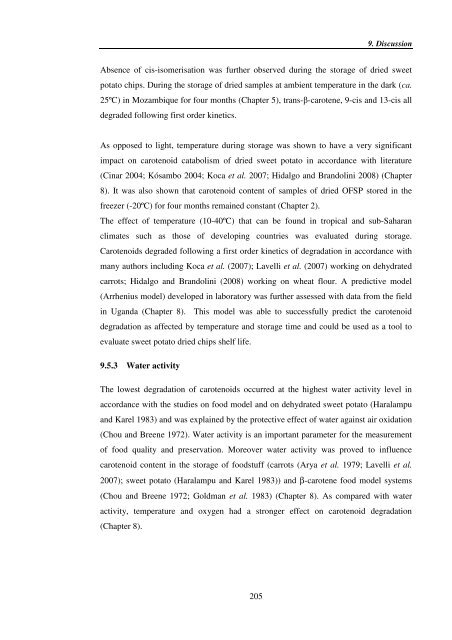Investigating carotenoid loss after drying and storage of
Investigating carotenoid loss after drying and storage of
Investigating carotenoid loss after drying and storage of
Create successful ePaper yourself
Turn your PDF publications into a flip-book with our unique Google optimized e-Paper software.
205<br />
9. Discussion<br />
Absence <strong>of</strong> cis-isomerisation was further observed during the <strong>storage</strong> <strong>of</strong> dried sweet<br />
potato chips. During the <strong>storage</strong> <strong>of</strong> dried samples at ambient temperature in the dark (ca.<br />
25ºC) in Mozambique for four months (Chapter 5), trans-!-carotene, 9-cis <strong>and</strong> 13-cis all<br />
degraded following first order kinetics.<br />
As opposed to light, temperature during <strong>storage</strong> was shown to have a very significant<br />
impact on <strong>carotenoid</strong> catabolism <strong>of</strong> dried sweet potato in accordance with literature<br />
(Cinar 2004; Kósambo 2004; Koca et al. 2007; Hidalgo <strong>and</strong> Br<strong>and</strong>olini 2008) (Chapter<br />
8). It was also shown that <strong>carotenoid</strong> content <strong>of</strong> samples <strong>of</strong> dried OFSP stored in the<br />
freezer (-20ºC) for four months remained constant (Chapter 2).<br />
The effect <strong>of</strong> temperature (10-40ºC) that can be found in tropical <strong>and</strong> sub-Saharan<br />
climates such as those <strong>of</strong> developing countries was evaluated during <strong>storage</strong>.<br />
Carotenoids degraded following a first order kinetics <strong>of</strong> degradation in accordance with<br />
many authors including Koca et al. (2007); Lavelli et al. (2007) working on dehydrated<br />
carrots; Hidalgo <strong>and</strong> Br<strong>and</strong>olini (2008) working on wheat flour. A predictive model<br />
(Arrhenius model) developed in laboratory was further assessed with data from the field<br />
in Ug<strong>and</strong>a (Chapter 8). This model was able to successfully predict the <strong>carotenoid</strong><br />
degradation as affected by temperature <strong>and</strong> <strong>storage</strong> time <strong>and</strong> could be used as a tool to<br />
evaluate sweet potato dried chips shelf life.<br />
9.5.3 Water activity<br />
The lowest degradation <strong>of</strong> <strong>carotenoid</strong>s occurred at the highest water activity level in<br />
accordance with the studies on food model <strong>and</strong> on dehydrated sweet potato (Haralampu<br />
<strong>and</strong> Karel 1983) <strong>and</strong> was explained by the protective effect <strong>of</strong> water against air oxidation<br />
(Chou <strong>and</strong> Breene 1972). Water activity is an important parameter for the measurement<br />
<strong>of</strong> food quality <strong>and</strong> preservation. Moreover water activity was proved to influence<br />
<strong>carotenoid</strong> content in the <strong>storage</strong> <strong>of</strong> foodstuff (carrots (Arya et al. 1979; Lavelli et al.<br />
2007); sweet potato (Haralampu <strong>and</strong> Karel 1983)) <strong>and</strong> β-carotene food model systems<br />
(Chou <strong>and</strong> Breene 1972; Goldman et al. 1983) (Chapter 8). As compared with water<br />
activity, temperature <strong>and</strong> oxygen had a stronger effect on <strong>carotenoid</strong> degradation<br />
(Chapter 8).






